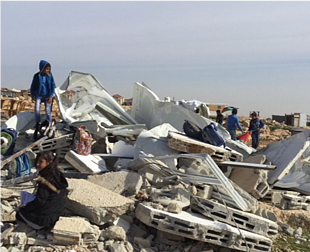West Bank demolitions and displacement | February 2018
Highlights
- Slight increase in demolitions and seizures during February.
- Most structures targeted supported agricultural, herding and commercial livelihoods.
- Eight EU-funded structures demolished or seized, including a school in an area planned for settlement expansion.
Demolitions and displacement: February 2018 overview
 February 2018 recorded a slight increase in the scope of the Israeli authorities’ demolitions and seizures across the West Bank (37 structures targeted), compared to the previous month (33 structures), as well as with the 2017 monthly average (35 structures). All but one of this month’s demolitions and seizures were carried out on grounds of lack of building permits, and were almost equally distributed between Area C and East Jerusalem.
February 2018 recorded a slight increase in the scope of the Israeli authorities’ demolitions and seizures across the West Bank (37 structures targeted), compared to the previous month (33 structures), as well as with the 2017 monthly average (35 structures). All but one of this month’s demolitions and seizures were carried out on grounds of lack of building permits, and were almost equally distributed between Area C and East Jerusalem.
Eight of the structures targeted this month were residential, resulting in the displacement of 44 Palestinians, including 24 children, 20 per cent below the 2017 monthly average of people displaced in this context. One of the affected homes was funded by the EU as humanitarian assistance to a family displaced in a previous demolition in the Bedouin community of Jabal al Baba, in the Jerusalem governorate, in an area planned for the expansion of the Ma’ale Adumim settlement (E1).
All but one of the other structures targeted this month supported the agricultural, herding and commercial livelihoods of communities, including animal shelters, storage rooms, water wells, irrigation pipelines, and shops. Six of these structures were EU-funded humanitarian aid delivered to two Area C communities: Um al Jmal in the northern Jordan Valley, and Al Bowereh in the Hebron governorate, in response to previous demolitions.
Jabal al Baba and Um al Jmal are two of the Palestinian communities which, in November 2017, received “demarcation orders” issued by the Israeli military ordering the “removal of all properties” from them. Objections filed against those orders were rejected. These are the first incidents recorded in these communities since the issuance of the demarcation orders.
One of the animal shelters destroyed this month was in the Area A village of Birqin (Jenin) during a military operation aimed to capture the suspected perpetrators of a shooting attack on 9 January 2018, in which an Israeli settler was killed. This is the fifth structure destroyed, so far in 2018, during a military operation. Another four residential apartments were damaged during the incident, temporarily displacing 15 people (not included in the totals).
Another community targeted this month was Abu Nuwar in the Jerusalem governorate, where the Israeli authorities demolished two newly built EU-funded classrooms, which served 26 third and fourth grade students. This is the sixth demolition or confiscation incident in Abu Nuwar school since February 2016. Similar to Jabal al Baba, Abu Nuwar is located in the strategic area of the E1 plan. Both are among the 46 communities in the central West Bank at risk of forcible transfer due to the coercive environment exerted upon them, including the promotion of relocation plans. The acting Humanitarian Coordinator for the oPt, Roberto Valent, raised concerns over the targeting of the school and called on the Israeli authorities to fulfill their obligations under international law and immediately cease all practices generating a risk of forcible transfer. Partners in the education sector have identified 36 schools in Area C and eight in East Jerusalem that are currently at risk of full or partial demolition due to outstanding orders (see map). Twenty-one (21) of the schools at risk have been provided with some form of assistance from the EU and its Member States.
Charts and tables with additional figures are available in the full version of this report.









